Yi Lu
Understanding Chain-of-Thought in Large Language Models via Topological Data Analysis
Dec 22, 2025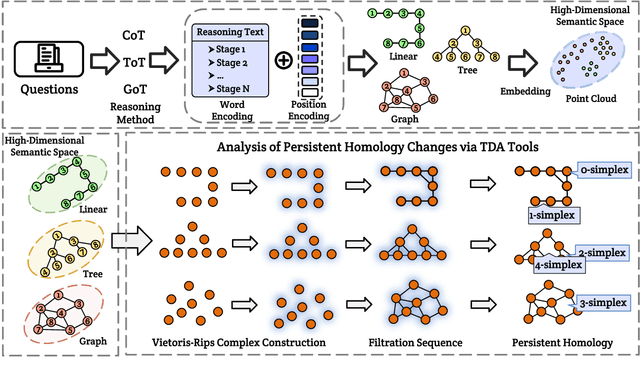
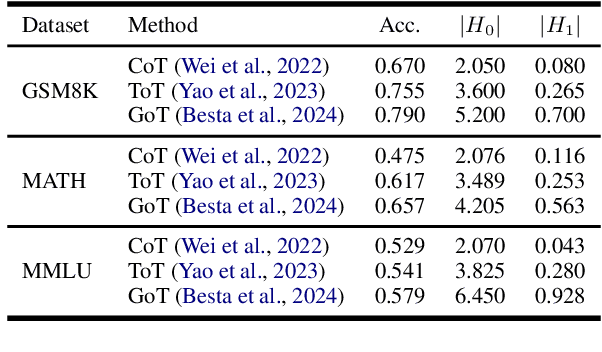
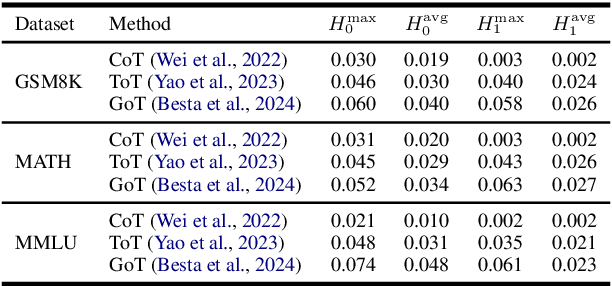
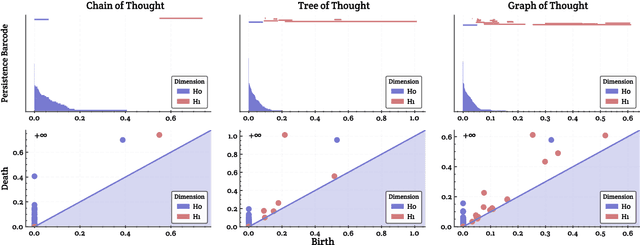
Abstract:With the development of large language models (LLMs), particularly with the introduction of the long reasoning chain technique, the reasoning ability of LLMs in complex problem-solving has been significantly enhanced. While acknowledging the power of long reasoning chains, we cannot help but wonder: Why do different reasoning chains perform differently in reasoning? What components of the reasoning chains play a key role? Existing studies mainly focus on evaluating reasoning chains from a functional perspective, with little attention paid to their structural mechanisms. To address this gap, this work is the first to analyze and evaluate the quality of the reasoning chain from a structural perspective. We apply persistent homology from Topological Data Analysis (TDA) to map reasoning steps into semantic space, extract topological features, and analyze structural changes. These changes reveal semantic coherence, logical redundancy, and identify logical breaks and gaps. By calculating homology groups, we assess connectivity and redundancy at various scales, using barcode and persistence diagrams to quantify stability and consistency. Our results show that the topological structural complexity of reasoning chains correlates positively with accuracy. More complex chains identify correct answers sooner, while successful reasoning exhibits simpler topologies, reducing redundancy and cycles, enhancing efficiency and interpretability. This work provides a new perspective on reasoning chain quality assessment and offers guidance for future optimization.
It is not always greener on the other side: Greenery perception across demographics and personalities in multiple cities
Dec 19, 2025Abstract:Quantifying and assessing urban greenery is consequential for planning and development, reflecting the everlasting importance of green spaces for multiple climate and well-being dimensions of cities. Evaluation can be broadly grouped into objective (e.g., measuring the amount of greenery) and subjective (e.g., polling the perception of people) approaches, which may differ -- what people see and feel about how green a place is might not match the measurements of the actual amount of vegetation. In this work, we advance the state of the art by measuring such differences and explaining them through human, geographic, and spatial dimensions. The experiments rely on contextual information extracted from street view imagery and a comprehensive urban visual perception survey collected from 1,000 people across five countries with their extensive demographic and personality information. We analyze the discrepancies between objective measures (e.g., Green View Index (GVI)) and subjective scores (e.g., pairwise ratings), examining whether they can be explained by a variety of human and visual factors such as age group and spatial variation of greenery in the scene. The findings reveal that such discrepancies are comparable around the world and that demographics and personality do not play a significant role in perception. Further, while perceived and measured greenery correlate consistently across geographies (both where people and where imagery are from), where people live plays a significant role in explaining perceptual differences, with these two, as the top among seven, features that influences perceived greenery the most. This location influence suggests that cultural, environmental, and experiential factors substantially shape how individuals observe greenery in cities.
HLTCOE Evaluation Team at TREC 2025: VQA Track
Dec 08, 2025Abstract:The HLTCOE Evaluation team participated in TREC VQA's Answer Generation (AG) task, for which we developed a listwise learning framework that aims to improve semantic precision and ranking consistency in answer generation. Given a video-question pair, a base multimodal model first generates multiple candidate answers, which are then reranked using a model trained with a novel Masked Pointer Cross-Entropy Loss with Rank Weights. This objective integrates pointer-based candidate selection, rank-dependent weighting, and masked cross-entropy under vocabulary restriction, enabling stable and interpretable listwise optimization. By bridging generative modeling with discriminative ranking, our method produces coherent, fine-grained answer lists. Experiments reveal consistent gains in accuracy and ranking stability, especially for questions requiring temporal reasoning and semantic disambiguation.
A Rigorous Benchmark with Multidimensional Evaluation for Deep Research Agents: From Answers to Reports
Oct 02, 2025Abstract:Artificial intelligence is undergoing the paradigm shift from closed language models to interconnected agent systems capable of external perception and information integration. As a representative embodiment, Deep Research Agents (DRAs) systematically exhibit the capabilities for task decomposition, cross-source retrieval, multi-stage reasoning, and structured output, which markedly enhance performance on complex and open-ended tasks. However, existing benchmarks remain deficient in evaluation dimensions, response formatting, and scoring mechanisms, limiting their capacity to assess such systems effectively. This paper introduces a rigorous benchmark and a multidimensional evaluation framework tailored to DRAs and report-style responses. The benchmark comprises 214 expert-curated challenging queries distributed across 10 broad thematic domains, each accompanied by manually constructed reference bundles to support composite evaluation. The framework enables comprehensive evaluation of long-form reports generated by DRAs, incorporating integrated scoring metrics for semantic quality, topical focus, and retrieval trustworthiness. Extensive experimentation confirms the superior performance of mainstream DRAs over web-search-tool-augmented reasoning models, yet reveals considerable scope for further improvement. This study provides a robust foundation for capability assessment, architectural refinement, and paradigm advancement in DRA systems.
SoccerNet 2025 Challenges Results
Aug 26, 2025Abstract:The SoccerNet 2025 Challenges mark the fifth annual edition of the SoccerNet open benchmarking effort, dedicated to advancing computer vision research in football video understanding. This year's challenges span four vision-based tasks: (1) Team Ball Action Spotting, focused on detecting ball-related actions in football broadcasts and assigning actions to teams; (2) Monocular Depth Estimation, targeting the recovery of scene geometry from single-camera broadcast clips through relative depth estimation for each pixel; (3) Multi-View Foul Recognition, requiring the analysis of multiple synchronized camera views to classify fouls and their severity; and (4) Game State Reconstruction, aimed at localizing and identifying all players from a broadcast video to reconstruct the game state on a 2D top-view of the field. Across all tasks, participants were provided with large-scale annotated datasets, unified evaluation protocols, and strong baselines as starting points. This report presents the results of each challenge, highlights the top-performing solutions, and provides insights into the progress made by the community. The SoccerNet Challenges continue to serve as a driving force for reproducible, open research at the intersection of computer vision, artificial intelligence, and sports. Detailed information about the tasks, challenges, and leaderboards can be found at https://www.soccer-net.org, with baselines and development kits available at https://github.com/SoccerNet.
Graph-Guided Dual-Level Augmentation for 3D Scene Segmentation
Jul 30, 2025Abstract:3D point cloud segmentation aims to assign semantic labels to individual points in a scene for fine-grained spatial understanding. Existing methods typically adopt data augmentation to alleviate the burden of large-scale annotation. However, most augmentation strategies only focus on local transformations or semantic recomposition, lacking the consideration of global structural dependencies within scenes. To address this limitation, we propose a graph-guided data augmentation framework with dual-level constraints for realistic 3D scene synthesis. Our method learns object relationship statistics from real-world data to construct guiding graphs for scene generation. Local-level constraints enforce geometric plausibility and semantic consistency between objects, while global-level constraints maintain the topological structure of the scene by aligning the generated layout with the guiding graph. Extensive experiments on indoor and outdoor datasets demonstrate that our framework generates diverse and high-quality augmented scenes, leading to consistent improvements in point cloud segmentation performance across various models.
A Survey: Learning Embodied Intelligence from Physical Simulators and World Models
Jul 01, 2025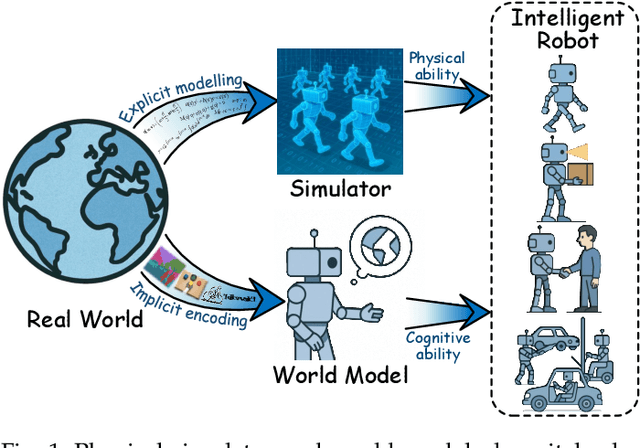



Abstract:The pursuit of artificial general intelligence (AGI) has placed embodied intelligence at the forefront of robotics research. Embodied intelligence focuses on agents capable of perceiving, reasoning, and acting within the physical world. Achieving robust embodied intelligence requires not only advanced perception and control, but also the ability to ground abstract cognition in real-world interactions. Two foundational technologies, physical simulators and world models, have emerged as critical enablers in this quest. Physical simulators provide controlled, high-fidelity environments for training and evaluating robotic agents, allowing safe and efficient development of complex behaviors. In contrast, world models empower robots with internal representations of their surroundings, enabling predictive planning and adaptive decision-making beyond direct sensory input. This survey systematically reviews recent advances in learning embodied AI through the integration of physical simulators and world models. We analyze their complementary roles in enhancing autonomy, adaptability, and generalization in intelligent robots, and discuss the interplay between external simulation and internal modeling in bridging the gap between simulated training and real-world deployment. By synthesizing current progress and identifying open challenges, this survey aims to provide a comprehensive perspective on the path toward more capable and generalizable embodied AI systems. We also maintain an active repository that contains up-to-date literature and open-source projects at https://github.com/NJU3DV-LoongGroup/Embodied-World-Models-Survey.
StructEval: Benchmarking LLMs' Capabilities to Generate Structural Outputs
May 26, 2025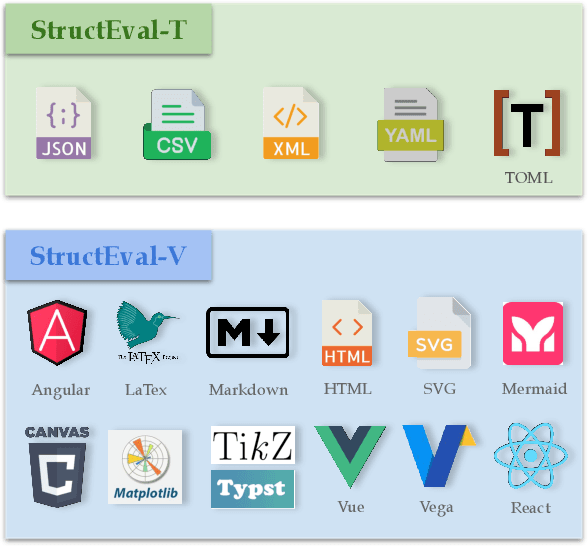
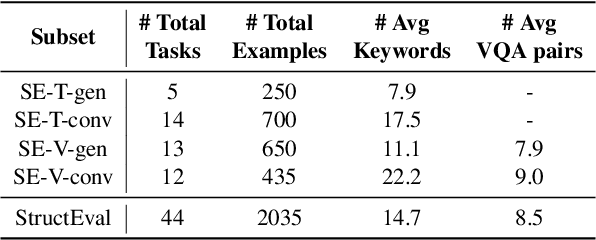
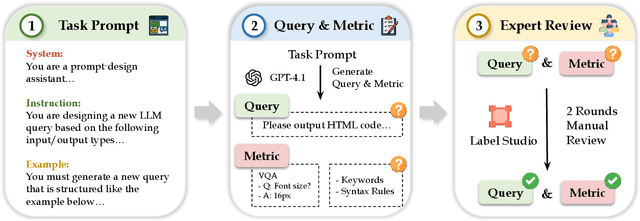

Abstract:As Large Language Models (LLMs) become integral to software development workflows, their ability to generate structured outputs has become critically important. We introduce StructEval, a comprehensive benchmark for evaluating LLMs' capabilities in producing both non-renderable (JSON, YAML, CSV) and renderable (HTML, React, SVG) structured formats. Unlike prior benchmarks, StructEval systematically evaluates structural fidelity across diverse formats through two paradigms: 1) generation tasks, producing structured output from natural language prompts, and 2) conversion tasks, translating between structured formats. Our benchmark encompasses 18 formats and 44 types of task, with novel metrics for format adherence and structural correctness. Results reveal significant performance gaps, even state-of-the-art models like o1-mini achieve only 75.58 average score, with open-source alternatives lagging approximately 10 points behind. We find generation tasks more challenging than conversion tasks, and producing correct visual content more difficult than generating text-only structures.
Effective Length Extrapolation via Dimension-Wise Positional Embeddings Manipulation
Apr 26, 2025Abstract:Large Language Models (LLMs) often struggle to process and generate coherent context when the number of input tokens exceeds the pre-trained length. Recent advancements in long-context extension have significantly expanded the context window of LLMs but require expensive overhead to train the large-scale models with longer context. In this work, we propose Dimension-Wise Positional Embeddings Manipulation (DPE), a training-free framework to extrapolate the context window of LLMs by diving into RoPE's different hidden dimensions. Instead of manipulating all dimensions equally, DPE detects the effective length for every dimension and finds the key dimensions for context extension. We reuse the original position indices with their embeddings from the pre-trained model and manipulate the key dimensions' position indices to their most effective lengths. In this way, DPE adjusts the pre-trained models with minimal modifications while ensuring that each dimension reaches its optimal state for extrapolation. DPE significantly surpasses well-known baselines such as YaRN and Self-Extend. DPE enables Llama3-8k 8B to support context windows of 128k tokens without continual training and integrates seamlessly with Flash Attention 2. In addition to its impressive extrapolation capability, DPE also dramatically improves the models' performance within training length, such as Llama3.1 70B, by over 18 points on popular long-context benchmarks RULER. When compared with commercial models, Llama 3.1 70B with DPE even achieves better performance than GPT-4-128K.
VEU-Bench: Towards Comprehensive Understanding of Video Editing
Apr 24, 2025



Abstract:Widely shared videos on the internet are often edited. Recently, although Video Large Language Models (Vid-LLMs) have made great progress in general video understanding tasks, their capabilities in video editing understanding (VEU) tasks remain unexplored. To address this gap, in this paper, we introduce VEU-Bench (Video Editing Understanding Benchmark), a comprehensive benchmark that categorizes video editing components across various dimensions, from intra-frame features like shot size to inter-shot attributes such as cut types and transitions. Unlike previous video editing understanding benchmarks that focus mainly on editing element classification, VEU-Bench encompasses 19 fine-grained tasks across three stages: recognition, reasoning, and judging. To enhance the annotation of VEU automatically, we built an annotation pipeline integrated with an ontology-based knowledge base. Through extensive experiments with 11 state-of-the-art Vid-LLMs, our findings reveal that current Vid-LLMs face significant challenges in VEU tasks, with some performing worse than random choice. To alleviate this issue, we develop Oscars, a VEU expert model fine-tuned on the curated VEU-Bench dataset. It outperforms existing open-source Vid-LLMs on VEU-Bench by over 28.3% in accuracy and achieves performance comparable to commercial models like GPT-4o. We also demonstrate that incorporating VEU data significantly enhances the performance of Vid-LLMs on general video understanding benchmarks, with an average improvement of 8.3% across nine reasoning tasks.
 Add to Chrome
Add to Chrome Add to Firefox
Add to Firefox Add to Edge
Add to Edge